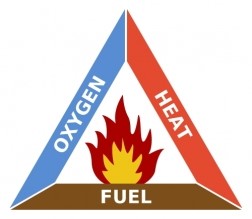Fire is the rapid oxidation of a material in the exothermic chemical process of combustion, releasing heat, light, and various reaction products.
The Three Basic Requirements of Fire are
- A Fuel Source
- Oxygen Availability
- Ignition Source
No fire can take place without all the three. Although ignition is usually a one off event in practice the types of fuel will vary from furnishings & fittings in the building industry, crude oil, gas or a mixture of both sometimes under the pressure in the petrochemical & off shore industries & storage of flammable in the chemical & off shore industries.
The degree of oxygen availability will also vary dependent upon whether there are enclosed modules in the building & offshore industries or whether there are open structures in the petrochemical or offshore industries.
With the many varying conditions of fuel supply, oxygen and geometry – this means that many different actual fire conditions can & will occur. In order to provide basic criteria against which construction may be tested, standard fire test have been developed.
These are designed to be a reasonable representation of free burning fires and where originally based and worked on in the late 19th, century and redefined over the intervening years.

Fig 1 Fire Triangle
Typical hydrocarbon fires
Hydrocarbon fire
– a fire fuelled by hydrocarbon compounds, which reaches temperatures of around 1100°C almost instantaneously after ignition.
Pool fire
– a turbulent fire that can occur when flammable liquid spills ignites producing heat fluxes of 120 –150 kw/sqm. And flame temperature of 1000 – 1200°C
Jet fires
– jet fires is the name given to a turbulent high velocity flame resulting from the combustion of a steady release of pressurized hydrocarbon fuels which are ignited, it is usually gas that is the assumed fuel but other are also possible the jet fire is characterized by a high velocity of 50-60 meters per second which creates huge turbulence when it impacts the surface. Heat flux may be instantaneously as high as 350 kW per square meter. and flame temperature up to 1500°C whilst jet fires are usually much smaller than pool fires they are much more intense and can cause rapid failure where they impinge directly onto a structure or a vessel. The erosive properties of such a jet fire could cause sever damages to many organic fire protection materials
Ignited blowout
– a special type of jet fire caused by the high pressure flow of burning oil and gas from an uncontrolled well with a substantial rain of unburned heavy fractions back onto the installation causing other pool fires these types of fire are most likely to occur during drilling operations.
BLEVE or fireball
– a boiling liquid expanding vapor explosion caused by the catastrophic failure of a pressure vessel containing liquid or gaseous fuel. The size of the fireball depends on the fuel mass released.
Running liquid fire
an ignited liquid fuel fire flowing continuously over a hot metal surface
What is passive fire protection?
The term passive fire protection is used to describe such coatings systems which become a part of the construction element which is primarily designed to protect hydrocarbon vessels and structural steel frames from collapsing in the event of a fire and further the ability to restrict the fire within the designated compartment to minimize the severity and intensity of the fire and finally protect the adjacent areas from destruction and also from secondary fires.
There are two types of fire protection systems, active and passive.
Why the need to Passive Fireproof?
When fire starts in a structural steel designed building or in a potential hazardous installation it may endanger life and cause severe damages to the structures. The devastating result of the fire could be catastrophic it is therefore imperative that all load bearing steel structures and hydrocarbon vessels are protected so that they maintain stability for the duration of a fire until additional fire control measures have been considered Since many common building materials such as steel and concrete do not burn. Fire protection of structures made from these materials is not an obvious requirement. They have a long tradition of use in the building industry and it is not until one examines in detail their performance under fire conditions that the need for protecting them from fire becomes apparent
STEEL As we know looses it ability to carry load as temperature increases. Structures loaded to normal design limits will collapse when they reach a critical temperature of approximately 550°C and similarly vessels may actually burst due to BLEVE phenomenon.
One hears references of item such as STABILITY, INTEGRITY & INSULATION when relating to passive fire protection materials & I will therefore try & clarify the meaning of these in relation to structural fire protection.
- STABILITY – is the criteria to stay in position & support design loads in fire
- INTEGRITY – is the criteria to stop fire spread by allowing flames & hot gases to penetrate &
- INSULATION – is the criteria to stop temperature rise exceeding a set limit.